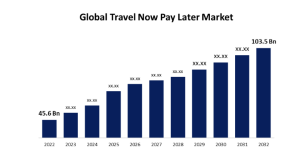In recent years, the travel industry has witnessed a shift in ease of access with the rise of innovative financial solutions such as ‘Travel Now, Pay Later.’ This novel approach allows travelers to embark on their dream vacations without the need for immediate finances, presenting a unique fusion of traveling at ease and financial flexibility.
The surge in popularity of Travel Now, Pay Later (TNPL) programs can be attributed to their ability to allow individuals to fulfill their aspirations in exploring the world. By decoupling the immediate financing need from travel, these programs open doors for those who might have deferred their travel dreams due to financial constraints. The rise of Travel Now, Pay Later signifies a departure from traditional travel financing methods, fostering a more inclusive approach to tourism and aligning with the evolving aspirations of modern travelers seeking both adventure and fiscal prudence. The Global Travel Now, Pay Later Market Size is expected to reach USD 103.5 Billion by 2032, at a CAGR of 8.6% during the forecast period 2023 to 2032.

Source: Spherical Insights
However, much like any aspect of the financial services industry, TNPL too is not without its share of challenges and risks.
The potential issues of Travel Now, Pay Later
Consider Sarah, an avid traveler, who decides to fulfill her dream of exploring the vibrant streets of Tokyo using a popular travel financing plan. The deal promises easy monthly payments with no upfront costs. Excited, Sarah books her flights, accommodations, and activities through the program, envisioning a seamless journey without the immediate financial burden.
However, as she starts the repayment journey, Sarah notices that the monthly payments are higher than expected. Upon scrutinizing the terms and conditions, she discovered hidden fees, transaction costs, and additional charges that were not clearly outlined during the booking process. These unanticipated expenses not only inflate the overall cost of her trip but also catch her off guard, challenging the budget that she had meticulously planned.
In this scenario, the issue is not just the financial burden but the lack of transparency in the ‘Travel Now, Pay Later’ plan. This example underscores the importance of thoroughly understanding the terms, conditions, and associated costs before committing to deferred payment options to ensure a truly hassle-free travel adventure.
Based on the above example, it is clear that in the pursuit of informed decision-making within the domain of travel financing, it is imperative to scrutinize the potential issues and risks embedded in ‘Travel Now, Pay Later’ programs. Below, we shed light on the intricate complexities and potential pitfalls that demand careful consideration before embarking on such financial arrangements.
Issue 1: Ambiguous fee structures and unforeseen costs
One of the foremost concerns associated with ‘Travel Now, Pay Later’ programs lies in the fee structures and unforeseen financial burdens. Many programs, while promising flexibility, often present ambiguous fee structures. Travelers may encounter hidden fees, undisclosed service charges, and unanticipated costs that become apparent only during the course of their financial commitment. Such a lack of transparency poses a significant risk to the traveler’s budgetary planning and may lead to unwarranted financial strain.
Issue 2: High-interest rates and financial over-commitment
The USP of deferred payments may come at the cost of elevated interest rates. ‘Travel Now, Pay Later’ programs, while providing immediate access to travel experiences, often accompany high interest rates that can substantially augment the overall cost of the trip. Travelers may find themselves needing help with financial overcommitment, challenging the initial perception of an affordable and convenient financial arrangement. The cumulative impact of interest rates must be meticulously evaluated to avoid unforeseen financial burdens.
Issue 3: Limited flexibility and restrictive terms
Travelers opting for ‘Travel Now, Pay Later’ programs may encounter limitations in terms of flexibility and restrictive contractual terms. The inflexibility of repayment plans, coupled with stringent terms and conditions, can constrain the traveler’s ability to adapt to unforeseen circumstances. This lack of adaptability poses a risk, particularly in situations where unexpected events disrupt travel plans, potentially leading to financial penalties or contractual complexities.
Issue 4: Impact on credit score and financial standing
Engaging in ‘Travel Now, Pay Later’ programs may have repercussions on an individual’s credit score and overall financial standing. The financial commitments associated with these programs, if not managed diligently, can result in missed payments or financial strain, impacting the traveler’s creditworthiness. This, in turn, may have cascading effects on future financial endeavors and credit-related opportunities.
Conclusion: Navigating the Delicate Balance
In the pursuit of seamless travel experiences through ‘Travel Now, Pay Later’ programs, a discerning approach is imperative. The issues and risks outlined serve as a foundational guide for travelers to make informed decisions, ensuring that the allure of immediate exploration does not compromise financial stability.
Key considerations include:
- Thorough understanding of fee structures
- Careful evaluation of interest rates
- Scrutiny of contractual terms
- Awareness of potential credit implications
By exercising diligence in these areas, travelers can enjoy the benefits of ‘Travel Now, Pay Later’ programs while safeguarding their financial well-being. This balanced approach enables them to embark on their adventures with confidence and peace of mind.
Recommended Read: The Rise of Travel Now, Pay Later
FAQs:
Q1: What is the essence of Travel Now, Pay Later programs?
Travel Now, Pay Later programs offer a financial solution that allows individuals to book and enjoy their travel experiences while deferring the immediate financial burden. These programs typically involve installment plans, allowing travelers to spread the cost of their trip over a set period.
Q2: How do Travel Now, Pay Later programs work, and what are the key features?
Travel Now, Pay Later programs work by providing users with the flexibility to pay for their travel expenses in installments. Users can secure their bookings with an initial deposit and then pay off the remaining balance in agreed-upon installments. Key features often include low or zero-interest rates, minimal upfront costs, and the ability to customize payment plans.
Q3: What are the potential benefits of opting for Travel Now, Pay Later?
Opting for Travel Now, Pay Later can offer several benefits. It enables individuals to fulfill their travel aspirations without a substantial upfront payment, making travel more accessible. Additionally, these programs often come with flexible repayment terms, allowing travelers to manage their budgets more effectively.
Q4: Are there any risks or considerations associated with Travel Now, Pay Later?
While Travel Now, Pay Later programs provide financial flexibility, being aware of potential risks is crucial. Hidden fees, high-interest rates, and stringent terms can impact the overall cost and experience. It’s essential to thoroughly understand the terms and conditions, including repayment obligations, to ensure a seamless and financially sound travel experience.




